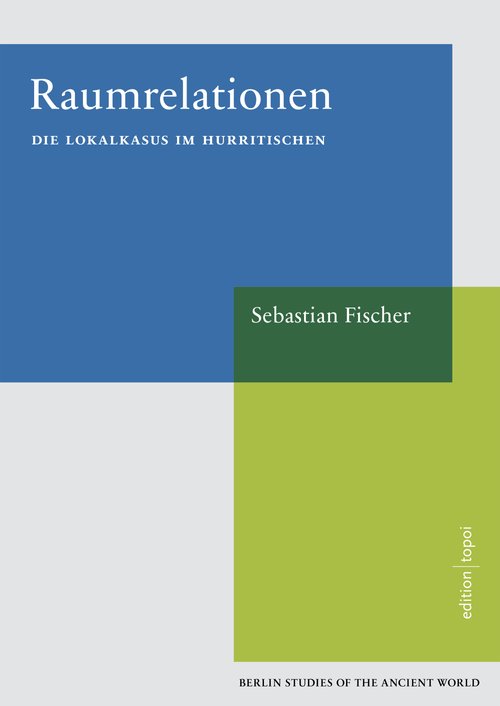Raumrelationen. Die Lokalkasus im Hurritischen
Abstract
Die Untersuchung der Lokalkasus ergab eine Reihe neuer Ergebnisse und Präzisierungen. Dem Funktionsbereich des Ablativs -dan kann die Angabe des Stimulus hinzugefügt werden, auch wenn es sich bislang nur um ein Beispiel handelt. Unterstützung findet diese Annahme durch den ne-Kasus, der als Ablativ fungieren kann. Auch dort finden sich Beispiele der Markierung des Stimulus. Die typischen Funktionen des Essivs -a sind die Beschreibung eines Zustands und der Lokativ. Eine Richtungsangabe ist derart selten, dass sie als Ausnahme gelten muss und mit den beobachteten Interferenzen zwischen Essiv und Dativ -va zusammenhängen könnte. So kann der Dativ etwa auch als Lokativ verwendet werden. Der Dativ scheint sein Funktionsspektrum dahingehend zu erweitern, dass er anstelle des Direktivs -da gebraucht werden kann. Eine generelle Austauschbarkeit des Direktivs und Dativs ist nicht feststellbar. Bis auf sehr wenige Fälle wird der Direktiv stets als Richtungsangabe benutzt. Die verba dicendi treten in der Regel mit dem Direktiv auf. Einen Schwerpunkt der Arbeit bildete vor allem die Diskussion des ne-Kasus bzw. e-Kasus. In dieser Arbeit wird die Existenz eines ne-Kasus und eines e-Kasus vertreten. Der e-Kasus ist außerhalb der belegten Konstruktion mit relationalem Nomen schwernachweisbar, sondern oft lediglich aufgrund starker Indizien anzunehmen. Für den ne-Kasus möchte ich die Funktionen Ablativ (separativisch, ablativus modi), Markierung des Stimulus und Instrumentalansetzen. Dem e-Kasus ist meines Erachtens die Funktion Direktiv und Lokativ sowie der Ausdruck der Beziehung (“hinsichtlich, betreffs” oder Ähnliches) zuzuweisen. Möglicherweise aufgrund der graphischen (und vielleicht auch lautlichen) Ähnlichkeit des ne-Kasus mit dem e-Kasus, wenn letzterer nach dem Relator -ne erscheint, werden Strategien zur eindeutigen Bestimmung der Funktion des Kasus nötig. Diese können sein: a) eine eindeutige Semantik des Verbs, b) Verwendung der Kurzform -n des ne-Kasus und c) Verwendung eindeutiger Kasus wie des Direktivs –da oder des Ablativs -dan. Bei der großen zeitlichen und räumlichen Verbreitung des Hurritischen muss mit der Möglichkeit mehrerer Entwicklungslinien gerechnet werden, die sich verschiedener Lösungsstrategien bedienen. Wie schon länger bekannt ist, besitzt das Hurritische sowohl ‘Postpositionen‘ als auch ‘Präpositionen‘. Neben den bekannten Konstruktionen können im Boğazköy-Material Belege gefunden werden, die dafürsprechen, dass der Gebrauch dieses sprachlichen Mittels vielfältiger ist, als bislang angenommen wurde. Je nach Art der Konstruktion sind diese Wörter als relationale Nomen oder als Adpositionen anzusehen. Zu den zur Bildung der relationalen Nomen verwendeten Kasus (Direktiv, Dativ) ist möglicherweise der ne-Kasus/e-Kasus hinzuzufügen. Den Konstruktionstyp “relationales Nomen (e-Kasus) + Bezugswort im Genitiv”, der sich im Mittani-Brief findet, kann im Boğazköy-Material vorerst nicht nachgewiesen werden. Ein Übergang von ‘Postpositionen’ zu ‘Präpositionen’ kann anhand der Belege nicht begründet werden. Insgesamt scheint es verhältnismäßig wenig Adpositionen/relationale Nomen zu geben, die zudem selten benutzt werden, sodass anzunehmen ist, dass vor allem die Semantik der Verbalform zur Präzisierung von räumlichen Relationen beiträgt.
The study of the local cases yielded a number of new results and was able to clarify previous definitions. At least one attestation could add the indication of stimulus to the functional domain of the ablative -dan. This hypothesis is supported by the ne-case, which can also function as an ablative and similarly mark stimulus. The typical functions of the essive case -a include the description of a circumstantial and the locative. An indication of direction is so rare that the function must be considered exceptional and may be related to the interference observed between the essive and dative -va. Thus, the dative can also be used as a locative. The dative seems to expand its functional domainsuch that it can be used in place of the directive -da. A general interchange between the directive and the dative cannot be identified. Aside from a few attestations, the directive is always used to indicate direction. Verbs of speech usually occur with the directive. A greater part of the work is devoted to the discussion of the ne-case and e-case and argues for the existence of both a ne-case and an e-case. Examples for the e-case outside the attested constructions with relational nouns are difficult to prove, and must instead be assumed on the basis of other strong indicators. The ne-case can be associated with the function of the ablative (separative, ablativus modi) as well as the marking of the stimulus and instrument. The directive and locative functions as well as relational expression (“with regard to, concerning” or similar) should be assigned to the e-case. The graphical (and perhaps also phonetic) similarities of the ne-case with the e-case, particularly when the latter follows the relator -ne, produce the need for strategies to distinguish the case’s function unambiguously. These can include: a) clear verbal semantics; b) the use of -n as an abbreviated form of the ne-case; and c) the use of an unambiguous case such as the directive -da or the ablative -dan. Due to the large spatial and chronological spread of Hurrian, throughout which different solutions may have been applied, multiple lines of development must be considered. As has long been known, Hurrian uses both ‘postpositions’ as well as ‘prepositions’. In addition to these established constructions, evidence from Boğazköy suggests that the use of these linguistic devices is more diverse than has been previously recognized. Depending on the type of construction, these words should be interpreted either as relational nouns or as adpositions. The ne-/e-case may be added to those used to construct relational nouns (directive, dative). The type of construction “relational noun (e-case) + antecedent in genitive”, found in the Mittani Letter, is at present not attested in Boğazköy. The attestations provide no evidence for a transition from ‘postposition’ to ‘preposition’. Altogether, there seem to be relatively few adpositions or relational nouns. The few that are attested are rarely used, which suggests that the specification of spatial relations depends heavily on verbal semantics.

